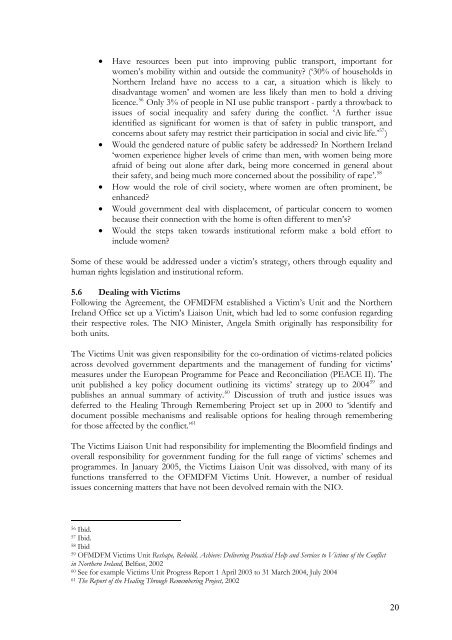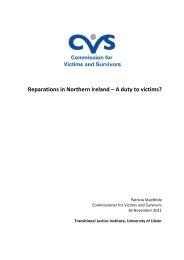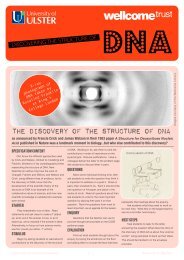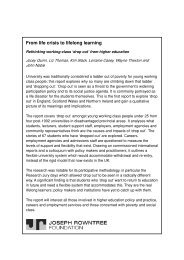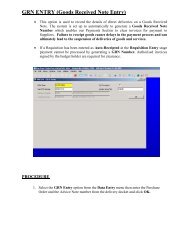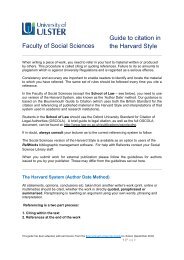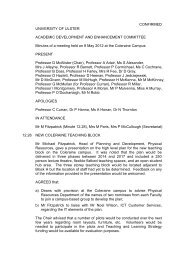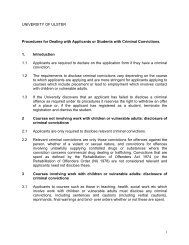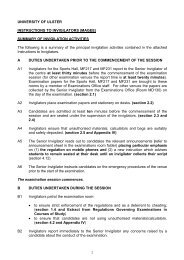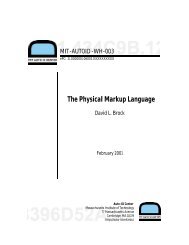Agreement Reached in the Multi-Party Negotiations - Transitional ...
Agreement Reached in the Multi-Party Negotiations - Transitional ...
Agreement Reached in the Multi-Party Negotiations - Transitional ...
Create successful ePaper yourself
Turn your PDF publications into a flip-book with our unique Google optimized e-Paper software.
• Have resources been put <strong>in</strong>to improv<strong>in</strong>g public transport, important for<br />
women’s mobility with<strong>in</strong> and outside <strong>the</strong> community? (‘30% of households <strong>in</strong><br />
Nor<strong>the</strong>rn Ireland have no access to a car, a situation which is likely to<br />
disadvantage women’ and women are less likely than men to hold a driv<strong>in</strong>g<br />
licence. 56 Only 3% of people <strong>in</strong> NI use public transport - partly a throwback to<br />
issues of social <strong>in</strong>equality and safety dur<strong>in</strong>g <strong>the</strong> conflict. ‘A fur<strong>the</strong>r issue<br />
identified as significant for women is that of safety <strong>in</strong> public transport, and<br />
concerns about safety may restrict <strong>the</strong>ir participation <strong>in</strong> social and civic life.’ 57 )<br />
• Would <strong>the</strong> gendered nature of public safety be addressed? In Nor<strong>the</strong>rn Ireland<br />
‘women experience higher levels of crime than men, with women be<strong>in</strong>g more<br />
afraid of be<strong>in</strong>g out alone after dark, be<strong>in</strong>g more concerned <strong>in</strong> general about<br />
<strong>the</strong>ir safety, and be<strong>in</strong>g much more concerned about <strong>the</strong> possibility of rape’. 58<br />
• How would <strong>the</strong> role of civil society, where women are often prom<strong>in</strong>ent, be<br />
enhanced?<br />
• Would government deal with displacement, of particular concern to women<br />
because <strong>the</strong>ir connection with <strong>the</strong> home is often different to men’s?<br />
• Would <strong>the</strong> steps taken towards <strong>in</strong>stitutional reform make a bold effort to<br />
<strong>in</strong>clude women?<br />
Some of <strong>the</strong>se would be addressed under a victim’s strategy, o<strong>the</strong>rs through equality and<br />
human rights legislation and <strong>in</strong>stitutional reform.<br />
5.6 Deal<strong>in</strong>g with Victims<br />
Follow<strong>in</strong>g <strong>the</strong> <strong>Agreement</strong>, <strong>the</strong> OFMDFM established a Victim’s Unit and <strong>the</strong> Nor<strong>the</strong>rn<br />
Ireland Office set up a Victim’s Liaison Unit, which had led to some confusion regard<strong>in</strong>g<br />
<strong>the</strong>ir respective roles. The NIO M<strong>in</strong>ister, Angela Smith orig<strong>in</strong>ally has responsibility for<br />
both units.<br />
The Victims Unit was given responsibility for <strong>the</strong> co-ord<strong>in</strong>ation of victims-related policies<br />
across devolved government departments and <strong>the</strong> management of fund<strong>in</strong>g for victims’<br />
measures under <strong>the</strong> European Programme for Peace and Reconciliation (PEACE II). The<br />
unit published a key policy document outl<strong>in</strong><strong>in</strong>g its victims’ strategy up to 2004 59 and<br />
publishes an annual summary of activity. 60 Discussion of truth and justice issues was<br />
deferred to <strong>the</strong> Heal<strong>in</strong>g Through Remember<strong>in</strong>g Project set up <strong>in</strong> 2000 to ‘identify and<br />
document possible mechanisms and realisable options for heal<strong>in</strong>g through remember<strong>in</strong>g<br />
for those affected by <strong>the</strong> conflict.’ 61<br />
The Victims Liaison Unit had responsibility for implement<strong>in</strong>g <strong>the</strong> Bloomfield f<strong>in</strong>d<strong>in</strong>gs and<br />
overall responsibility for government fund<strong>in</strong>g for <strong>the</strong> full range of victims’ schemes and<br />
programmes. In January 2005, <strong>the</strong> Victims Liaison Unit was dissolved, with many of its<br />
functions transferred to <strong>the</strong> OFMDFM Victims Unit. However, a number of residual<br />
issues concern<strong>in</strong>g matters that have not been devolved rema<strong>in</strong> with <strong>the</strong> NIO.<br />
56 Ibid.<br />
57 Ibid.<br />
58 Ibid<br />
59 OFMDFM Victims Unit Reshape, Rebuild, Achieve: Deliver<strong>in</strong>g Practical Help and Services to Victims of <strong>the</strong> Conflict<br />
<strong>in</strong> Nor<strong>the</strong>rn Ireland, Belfast, 2002<br />
60 See for example Victims Unit Progress Report 1 April 2003 to 31 March 2004, July 2004<br />
61 The Report of <strong>the</strong> Heal<strong>in</strong>g Through Remember<strong>in</strong>g Project, 2002<br />
20


